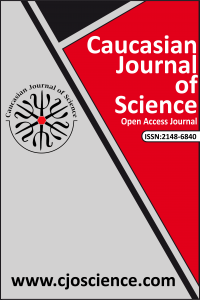MIDWIFERY STUDENTS EXPERIENCED DYSMENORRHOEA AND THEIR APPLICATIONS TO COPE WITH IT
MIDWIFERY STUDENTS EXPERIENCED DYSMENORRHOEA AND THEIR APPLICATIONS TO COPE WITH IT
Dysmenorrhoea, midwifery students cope with,
___
- 1. Yeşiltepe Ü, Şahin N. Perimenstrual problems of girls. Health and Community Journal. 2004; 14 (4): 55-59.
- 2. Çıtak N, Terzioğlu F. Knowledge and Practices of female students studying in Abant İzzet Baysal University regarding Primary Dysmenorrhoea. Health and Community Journal. 2002; 12 (3):69-80.
- 3. Tüzün H, İlhan F, Ceylan FN et al. (2005). Knowledge and attitudes of first year students of medical faculty regarding family planning and sexually transmitted diseases. Turkish Gynecology and obstetrics Journal 2(3):197-203.
- 4. Kulaksızoğlu A. Adolescent Psychology. İstanbul: Remzi Bookstore; 2001. s. 269
- 5. Angst J, Sellaro R, Merikangas KR, Endicott J. The epidemiology of premenstrual psychological symtoms. Acta Psychiatr Scand 2001; 104(2):110-116.
- 6. Taşkın L. Obstetrical and Women's Health Nursing. Ankara: Sistem Ofset Printing; 2012. p.500-501
- 7. Derman O. Common Problems in Adolescent Psychology. Vth International Reproductive Health and Family Planning Congress Book. Ankara:2007
- 8. Balbi N, Musone R, Menditto A, Di prisko L, Casse E, D’Ajello M, Ambrossio D, Cordenel A. Influence of menstrual factors and dietary habits on menstrual pain in adolesce age. Eur J Obstet Gynecol Repord Biol 2000; 91(2):143-148
- 9. Oskay YÜ, Şahin NH. Premenstrual problems of young girls. Health and Community October - December 2004; 4:55-59
- 10.Erenel A.Ş, Şentürk İ. Health High School Students Experienced Dysmenorrhoea and Their Applications to Cope with it. Journal of Hacettepe University School of Nursing; 2007: 47–60.
- 11. Taşçı K.D. Evaluation of Nursing Students' Premenstrual Symptoms. TAF Preventive Medicine Bulletin, 2006: 5 (6); 434-443.
- 12. Bölükbaşı N, Tiryaki N. Knowledge, attitude and behaviors of students about premenstrual syndrome. Forum of Nursing. 2003;(6): 344-50
- 13.Kocaöz S, Erdem Y, Yazıcı Gülten. Dysmenorrhoea in first-year students of a health high school: prevalence, Effect and Approaches: Vth International Reproductive Health and Family Planning Congress Book. Ankara: 2007.
- 14. Kısa S, Zeyneloğlu S, Güler N. Prevalence of Premenstrual Syndrome Among University Students And Affecting Factors. Gümüşhane University Journal of Health Sciences: 2012;1(4):284-297.
- 15. Kırcan N, Ergin F, Adana F, Arslantaş H. The Prevalence of Premenstrual Syndrome in Nursery Students and its Relationship with Quality of Life. ADÜ Medical Faculty Journal 2012;13(1):19-25.
- 16. Bourgeois JF PA Mullin Veljovich DS. Translated by Kazancı G. Obstetric and Gynaecologic Reminders. İstanbul: Nobel Tıp Bookstores; 2002. p. 512
- 17. Dökmeci F. Dysmenorrhoea: Diagnosis and Treatment. Vth International Reproductive Health and Family Planning Congress Book. Ankara:2007
- 18. Nusrat N, Nishat Z, Gulfareen H, Aftab Afroz M, Nisar AS. Frequency, Intensity and Impact of Premenstrual Syndrome in Medical Students. Journal of the College of Physicians and Surgeons Pakistan 2008; 18 (8): 481-484.
- 19. Demir B, Algül LY, Güvendağ Güven ES. Investigating Premenstrual Syndrome Incidence in Healthcare staff and affecting factors. Turk Soc Obstet Gynecol. 2006; 3 (4): 262-270.
- 20. Gençdoğan B. A new Scale for Premenstrual Syndrome. Psychiatry in Turkey 2006; 8(2): 81-87.
- 21. Dickerson LM, Mazyck PJ, Hunter MH. Premenstrual syndrome. American Family Physician 2003; 67(8): 43-52.
- 22.Halbreich U.The etiology, biology, and evolving pathology of premenstrual syndromes. Psychoneuroendocrinology 2003; 28 (3):55-99.
- Yayın Aralığı: Yılda 2 Sayı
- Başlangıç: 2014
- Yayıncı: Kafkas Üniversitesi
KERKÜK (IRAK) İLİ İÇME SUYUNUN KİMYASAL PARAMETRELERİ AÇISINDAN DEĞERLENDİRİLMESİ
Yawooz Hameed MAHMOOD, Murat KÜTÜK, Tawis Mohammed Kamel AHMED
MIDWIFERY STUDENTS EXPERIENCED DYSMENORRHOEA AND THEIR APPLICATIONS TO COPE WITH IT
Gokhan BARİKAN, Hüseyim ERTAP, Mustafa YÜKSEK, Hasan MAMMADOV, Mevlüt KARABULUT
Muzaffer ALKAN, Abdurrahman GÜRBÜZ, Haydar YÜKSEK, Özlem GÜRSOY KOL, Zafer OCAK
ALBURNOIDES BIPUNCTATUS (BLOCH, 1782) (ACTINOPTERYGII, CYPRINIDAE)’UN KROMOZOMAL ÖZELLİKLERİ
Muhammet GAFFAROĞLU, Muradiye KARASU AYATA, Sevgi ÜNAL, Ercan KALKAN
DOĞUM AĞRISI KONTROLÜNDE KULLANILAN NONFARMAKOLOJİK YÖNTEMLER
BAZI CENTRO-POLYHEDRAL GRUPLARIN PELL UZUNLUKLARI
SOFT TOPOLOJİK UZAYLARIN TERS SİSTEMLERİ
